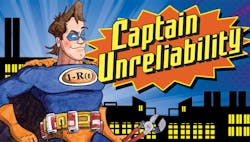How to design for unreliability
Being tasked with building a new line gives engineers the ability to showcase their skills. Here are five tips to help you showcase your skill or the lack thereof.
Tip #1: Engineer in your silo. Remember, YOU were tasked with the design of this line, not anyone else. YOU are the subject matter expert. YOU do not need others’ input. YOU are competent, strong, and independent and no one should be telling you what to change. You know how to do your job. Why take advice from those that know less than you? You are the all-encompassing knowledge powerhouse. Besides, your job is to deliver a line that fits in the real estate designated while delivering on time and under budget. Who needs help with that? I know YOU don’t!
Tip #2: Share critical information after commissioning. The goal is to keep all information about this project under wraps as much as possible. When word gets out, there is bound to be some feedback coming your way. Why deal with all the negative energy? They are just haters anyways, jealous that it is not them doing the project. Why give maintenance the ability to plan ahead for what critical spares may need to be ordered or what maintenance strategy should be developed? An unreliable best practice is to give maintenance all information about the equipment (i.e., manuals, schematics, drawings, etc.) six to eight weeks after the equipment has been commissioned.
Tip #3: Make the system as complex as possible. Why worry if you have the skillset to maintain this new line. That is an HR problem. You did not hire the personnel. This is your time to shine! Show the world your skills. Pad that resume.
Use as much technology as possible. For example, why put in a simple 90-degree conveyor to get the product from point A to point B when you can put in a pneumatic push arm with a bunch of sensors tied to a PLC that will push product from point A to point B?
Another idea is replacing humans with robots. Think about the labor you will save while showcasing your talent.
Tip #4: Practice value engineering. With the goal of on time and under budget, it is vitally important that you buy the cheapest parts and equipment as possible. How else are you going to fit robots into your budget? The goal here is to tell the OEM to get the cheapest possible parts when building it. Use knock off bearings and aftermarket components. Remember the two main components to value engineering are function and cost. As long as it functions when you hand it off to maintenance and operations and it was cheap, you have met the requirements.
How to develop a proper asset hierarchy
3 steps for creating an environment of personal responsibility within your facility
50 ways to be the leader you know yourself to be while trampling everyone in your path
Tip #5: Keep doing what you are doing. A typical project that begins with excitement, many times ends in disappointment. That’s okay, you can blame everyone else. Why resource plan? Why set goals and objectives? Why communicate? Not to mention, scope creep.
A project normally goes something like this: A new project is going to change the game for this organization. People are excited, waiting on the greatest thing they have ever seen. Then the project gets started and promises are made about a deadline that is impossible to hit. On top of that, everyone wants changes, some very dramatic, so more promises are made.
Deadlines are moved out and budget is expanded. Now we begin to do whatever it takes to get this project moving, even breaking our own rules in the process. Progress tracking goes out the window and accountability falls on the weakest link. The project continues to drag on and people begin to forget about it. Finally, someone remembers and decides to analyze where they went wrong. Then tough decisions are made: scrap the project and write off the assets, or rush to get everything completed by throwing money and headcount at it to get it finished as soon as possible. We designed a line to do 10 million units a year, and after five years the best we have achieved is 2.5 million so that becomes the new target with a stretch goal of possibly hitting 3 million.
So again, in the race for being the best, keep doing what you are doing. This is the greatest path to design for unreliability.
This story originally appeared in the May 2021 issue of Plant Services. Subscribe to Plant Services here.

